

|
| ABOUT | PRODUCTS | RESEARCH | BLOG | COMMUNITY |
|
|

Paint | Cleaning Titanium Frames | Traveling Colors | Imron Touchup | Fade Patterns | Rust At Spectrum we pride ourselves on our paint and finishing work. Over the years we've seen and painted just about everything you can imagine. We know a lot about bicycle paint and finish and we want to share it with you.
The main "trick" is to take preemptive action as much as possible rather than trying to clean a very dirty frame. That means wiping the bike down after each ride even when it looks clean. And when it comes to fingerprints and water-bottle drippings, there are a few things that help. Believe it or not, "Pledge" the furniture wax works really well on fingerprints. Not only does it help prevent dirt from sticking to the natural Titanium, but it also has some solvents that help in the cleaning of old dirt. Plain water is what you need for sport drink scunge. Ultimately though, natural titanium is a hassle. What most of our customers opt for is our no charge cleared natural finish. Although it is paint and therefore chip-able, the frame looks much better and is much easier to keep looking good.
Spectrum is very happy to offer Traveling Colors! These unique finishes add a little something extra to a custom frame's finish. Spectrum's "Traveling" colors actually change color as the angle at which they are viewed changes. It's kind of like the 100 in the bottom of our nations 50.00 and 100.00 dollar bills. The "100" in the lower right area will change color depending on the angle that you hold the paper. Check it out and you will see what I mean. While the ink that the Federal mint uses is made by a company called Flex Products (the people who actually own this technology) we get our hands on it through DuPont in the form of ChromaLusion paint. In its basic form, this paint has no pigment in it. Rather, it's made up of microscopic prisms that reflect and refract light. These prisms are cut from sheets that are less than on ten thousandth of an inch think. Each < 1 micron sheet is made up of five layers. The transparent outer layers cover an opaque middle layer that in turn covers semi-reflective base layers. The orientation of the prisms in 3 dimensional space determines the color of the paint. Simple physics right? Essentially there are four color families. One has a fire-red look at the perpendicular view, traveling through a variety of orange and gold colors when viewed at various angles. Another is a brilliant green traveling through reds, silvers or blues at different angles. Purple changing through silvers, greens and fuchsias is the third color family. And "Blasberry" rounds out the four with shifts through various blues, teals, violets, purples, burnt oranges, burgundies, and greens. At Spectrum we can further control these colors by using different base coats before application of the ChromaLusion. When it is all done, the frame appears to be painted in a few colors or shades of colors that dance around on the frame. The look is totally unique. Because the chemistry of the DuPont Chroma Premier product is quite different from Imron, we have to alter it so that Imron will stick to it. It took us a year and a lot of experimenting to figure out, but now our Traveling color paint jobs are just as tough as an Imron-only finish. The cost of ChromaLusion paint is about 25 times as much as standard Imron. Yup, it costs more if you choose this option.
Imron is a high-end polyurethane paint originally developed for the airline and trucking industries. Dupont's motto for Imron is; the wet look that lasts. The motto fits the product in this case.. It's a beautiful finish that will last and last but if it does chip or scratch, there are two routes you can go. We can send you one of our kits that includes the paint to match your existing color, and a bit of activator in separate container. The drawback to using Imron for touchup is that the activator is only good for a few days after you get it. It cannot be stored for long periods. The second route is to use model paint. Because your original Imron is a plastic, most paints designed to stick to plastic will work quite well. So take out those little bottles of paint you had as a kid. They work pretty well. If your paint is in really horrible shape, Spectrum can always refinish it for you. Give us a call to discuss price and timeframe.
With custom paint a standard feature on a Spectrum, I get a lot of questions about fades and fade options. A fade is when one color is painted next to another so that the two seem to bleed or blend into one another. Generally, any color except solids look great faded. Because solids are…well…solid, they don't fade very smoothly. Any colors made with translucent dyes will work well. These include all metallic colors, the ever-expanding line of candies and pearls, and even some of our bright neons and traveling colors. When designing a fade pattern, you will also need to decide how long you want the fades to be. We can go really short, like half an inch, or really long, like the length of the bike. It's up to you and it depends on the desired effect. As far as fade patterns go, it's all about personal preference. Generally I feel that fades work best if you go with an area transition to create some sort of flow to the look. As an example of how this should not be done, a frame with the second color around the head tube, seat cluster, bb and rear drops just looks kind of blotchy, no flow. It also helps if the transition lines are not left either vertical or horizontal. It tends to looks artificial with again no flow to the look. When choosing colors, remember that two faded colors will yield a third. The third color comes from the combination of the original two. Sometimes this looks good, sometimes bad. For examples: Fading from candy blue to candy green, the fade area can be a beautiful candy teal. Fading candy blue to candy yellow can create a pretty sick candy green. If you are into neons, fading from neon pink to neon orange can give an incredible neon sunset orange transition while fading neon red to neon green gives a dog poop brown. I don't know what you like but I try to avoid dog-poop colors. Basically, when it comes to paint, be careful. If you have some questions about a finish you are considering, call or e-mail and I'll help if I can.
Steel frames rust, that's all there is too it. They rust when scratched, chipped, or abraded in any way. Most people know this. What they don't know is that steel frames also rust from the inside out. That's why I am so amazed that manufacturers go through great pains to paint the outside of a frame but the completely ignore the inside surfaces of the steel tubes. The steel inside the frame is almost always left raw and unprotected. If a little moisture enters the frame, the environment within will resemble a terrarium. The humid air and water droplets will be attacking the steel and you won't even know it. Left untreated, the frame will be destroyed. To help prevent rust inside steel tubes, Frame Saver® was developed. It is a product that was long overdue. It coats the inside of the steel tubes protecting them from the corrosive elements that find their way in there. We use this stuff on every steel frame we ship and you should, especially now. True, bicycles have been around for 100 years and there are plenty of early examples of frames that have lasted lifetimes without rust, so why all the fuss now? Because in the last couple of decades there have been major changes in materials, equipment, and bike usage that have made internal frame protection more important. Today's high performance frames are being made with extremely thin walled tubing compared to frames of the past. There used to be a safety margin should the tubes rust. Not any more! There are a few construction details found in some frames that have trapped water and caused premature failures. Frame builders who do repair work, painters and mechanics, are seeing a higher incidence of rust-throughs these days, and it is only going to get worse, unless these frames are rustproofed on the inside. Most new bikes are equipped with sealed bearings, which mean fewer overhauls and fewer chances to look in the bottom bracket to see what is going on. After many carefree miles, many mechanics and owners are shocked when they pull the bottom bracket bearings and find rust-colored sludge, or flakes of rust, inside the shell. Hopefully, it's not too late to save a frame in this condition. Mountain bikes are supposed to be used in extreme conditions. Stream crossings, fall, winter, and early spring rides all involve, among other things, water. Even if you don't ride in the rain or cross raging rapids, moisture still finds its way into a frame. Take your bike out of a warm house on a cool, damp day, or on a hot day return your bike to a cool, damp basement for storage and what happens? As the warm air inside your frame cools and contracts, it pulls in the damp air past the seat post, threads, and vent holes. This may only be a minute amount, but do this many times over the course of the season and the cumulative effect can be devastating. It would be misleading to suggest that every steel frame is a risk because there are many factors involved. It is impossible to tell from the outside, which frames are screaming for attention. Why take a chance? With the cost of bikes these days, think of it as cheap insurance. Prevention is easy. An application of Frame Saver® will add years to a frame's life and peace of mind to its owner. May you both ride happily into the next millennium and beyond. Although this slightly modified reprinting of Peter's missive appears to be a commercial plug for him, everything he says here is absolutely true. We have seen quite a number of frames ruined by internal rust in our shop. A few of them were only two or three years old. If your steel frame has not been treated, either have someone do it for you, or get a can and do it yourself. Although there are other similar products on the market, none work as well or last as long as Frame Saver. Essentially, once properly applied, Frame Saver lasts as long as you keep your paint job. A chemical paint strip dipping will dissolve it, so be sure to re-apply once your have your frame repainted. You can pick up a spray can at most good pro shops.
|
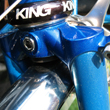
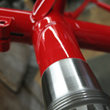
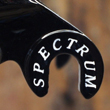
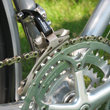
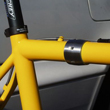
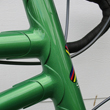
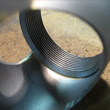








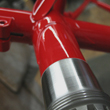
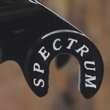
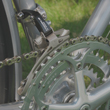
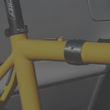
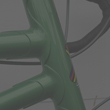
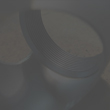
|